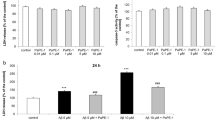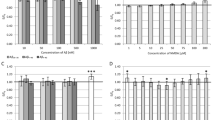Abstract
17β-estradiol (βE2) has been shown to attenuate the toxicity of β-amyloid peptides (Aβ) in neuronal cultures with the effective concentration of βE2 ranging from low nM to high μM. This study compares the effective neuroprotective concentration of βE2 against both Aβ-mediated toxicity in a human neuroblastoma cell line, SK-N-SH using cellular reduction of 3-(4,5-dimethylthiazol-2-yl)-2,5-diphenyltetrazolium bromide (MTT) as an endpoint to the effective βE2 concentration obtained using a calcein acetoxymethyl ester (calcein AM) viability assay. The minimum βE2 concentration required for protection varied 1000-fold between the two viability assays with 1 nM βE2 conferring significant protection in the calcein AM assay but 1 μM βE2 required for significant protection in the MTT assay. Interestingly, the maximal inhibition of MTT reduction occured at sub-toxic Aβ concentrations and did not correlate with other markers of cellular viability including calcein fluorescence, dye exclusion (propidium iodide or trypan blue), cellular ATP levels, or reduction of another tetrazolium dye, 5-(3-carboxymethoxyphenyl)-2-(4,5-dimethylthiazolyl)-3-(4-sulfophenyl) tetrazolium (MTS). By contrast, there was no difference between the MTT and calcein AM assays with respect to H2O2 toxicity or the neuroprotective effectiveness of 10 nM βE2 against H2 2 toxicity. These results indicate that low concentrations of βE2 can attenuate Aβ and H2O2 toxicity in a human neuroblastoma cell line. Further, these results suggest that the MTT assay is not an appropriate assay for the determination of βE2-mediated attenuation of Aβ toxicity.
Similar content being viewed by others
References
BEHL C., DAVIS, J. B., LESLEY, R. & SCHUBERT, D. (1994) Hydrogen peroxide mediates amyloid ? protein toxicity. Cell 77, 817–827.
BEHL, C., WIDMANN, M., TRAPP, T. & HOLSBOER, F. (1995) 17beta-estradiol protects neurons from oxidative stress-induced cell death in vitro. Biochemical and Biophysical Research Communications 216, 473–482.
BONNEFONT, A. B., MUNOZ, F. J. & INESTROSA, N. C. (1998) Estrogen protects neuronal cells from the cytotoxicity induced by acetylcholinesterase-amyloid complexes. FEBS Letters 441, 220–224.
GREEN, P. S., GRIDLEY, K. E. & SIMPKINS, J. W. (1996) Estradiol protects against ?-amyloid (25–35)-induced toxicity in SK-N-SH human neuroblastoma cells. Neuroscience Letters 218, 165–168.
GREEN, P. S., GRIDLEY, K. E. & SIMPKINS, J. W. (1998) Nuclear estrogen receptor-independent neuroprotection by estratrienes: A novel interaction with glutathione. Neuroscience 84, 7–10.
GREEN, P. S. & SIMPKINS, J. W. (2000) Neuroprotective effects of estrogens: Potential mechanisms of action. International Journal of Developmental Neuroscience 18, 34–58.
HERTEL, C., HAUSER, N., SCHUBENEL, R., SEILHEIMER, B. & KEMP, J. A. (1996) ?-Amyloid-induced cell toxicity: Enhancement of 3-(4,5-dimethylthiazol-2-yl)-2,5-diphenyltetrazolium bromide-dependent cell death. Journal of Neurochemistry 67, 272–276.
KAWAS, C., RESNICK, S., MORRISON, A., BROOKMEYER, R., CORRADA, M., ZONDERMAN, A., BACAL, C., LINGLE, D. D. & METTER, E. (1997) A prospective study of estrogen replacement therapy and the risk of developing Alzheimer's disease: The Baltimore Longitudinal Study of Aging. Neurology 48, 1517–1521.
KANEKO, I., YAMADA, N., SAKURABA Y., KAMENOSONO, M. & TUTUMI, S. (1995) Suppression of mitochondrial succinate dehydrogenase, a primary target of ?-amyloid, and its derivative racemized at Ser residue. Journal of Neurochemistry 65, 2585–2593.
LIU, Y. & SCHUBERT, D. (1997) Cytotoxic amyloid peptides inhibit cellular 3-(4,5-dimethyl-2-yl)-2,5-diphenyltetrazolium bromide (MTT) reduction by enhancing MTT formazan exocytosis. Journal of Neurochemistry 69, 2285–2293.
LIU, Y. & SCHUBERT, D. (1998) Steroid hormones block amyloid fibril-induced 3-(4,5-dimethyl-2-yl)-2,5-diphenyltetrazolium bromide (MTT) formazan exocytosis: Relationship to neurotoxicity. Journal of Neurochemistry 71, 2322–2329.
LOBNER, D. (2000) Comparison of the LDH & MTT assays for quantifying cell death: Validity for neuronal apoptosis? Journal of Neuroscience Methods 96, 147–152.
MARK, R. J., PANG, A., GEDDES, J. W., UCHIDA, K. & MATTSON, M. P. (1997) Amyloid ?-peptide impairs glucose transport in hippocampal and cortical neurons: Involvement of membrane lipid peroxidation. Journal of Neuroscience 71, 1046–1054.
MOOK-JUNG, I., JOO, I., SOHN, S., KWON, H. J., HUH, K. & JUNG, M. W. (1997) Estrogen blocks neurotoxic effects of beta-amyloid (1–42) and induces neurite extension on B103 cells. Neuroscience Letters 235, 101–104.
PIKE, C. J. (1999) Estrogen modulates neuronal bcl-xL expression and ?-amyloid-induced apoptosis: Relevance to Alzheimer's disease. Journal of Neurochemistry 72, 1552–1563.
PIKE, C. J., WALENCEWICZ, A. J., GLABE, C. G. & COTMAN, C. W. (1991) In vivo aging of ?-amyloid protein causes peptide aggregation and neurotoxicity. Brain Research 563, 311–314.
ROTH, A., SCHAFFNER, W. & HERTEL, C. (1999) Phytoestrogen kaempferol (3,4,5,7-tetrahydroxyflavone) protects PC12 and T47D cells from beta-amyloid-induced toxicity. Journal of Neuroscience Research 57, 399–404.
SHEARMAN, M. S. (1999) Toxicity of protein aggregates in PC12 cells: 3-(4,5-dimethylthiazol-2-yl)-2,5-diphenyltetrazolium bromide assay. Methods in Enzymology 309, 716–723.
SHEARMAN, M. S., HAWTIN, S. R. & TAILOR, V. J. (1995) The intracellular component of cellular 3-(4,5-dimethyl-2-yl)-2,5-diphenyltetrazolium bromide (MTT) reduction is specifically inhibited by ?-amyloid peptides. Journal of Neurochemistry 65, 218–227.
SHEARMAN, M. S., RAGAN, C. I. & IVERSEN, L. L. (1994) Inhibition of PC12 cell redox activity is a specific, early indicator of the mechanism of ?-amyloid-mediated cell death. Proceedings of the National Academy of Science of the USA 91, 1470–1474.
SLATER, T. F., SAWYER, B. & STRAULI, U. (1963) Studies on succinate-tetrazolium reductase systems. III. Points of coupling of four different tetrazolium salts. Biochimica et Biophysica Acta 77, 383–393.
TANG, M. X., JACOBS, D., STERN, Y., MARDER, K., SCHOFIELD, P., GURLAND, B., ANDREWS, H. & MAYEUX, R. (1996) Effect of oestrogen during menopause on risk and age at onset of Alzheimer's disease. Lancet 348, 429–432.
YANKER, B. A., DUFFY, L. K. & KIRSCHNER, D. A. (1990) Neurotrophic and neurotoxic effects of amyloid protein: Reversal by tachykinin neuroprptides. Science 25, 279–282.
ZHANG, Z., RYDEL, R. E., DRZEWIECKI, G. J., FUSON, K., WRIGHT, S., WOGULIS, M., AUDIA, J. E., MAY, P. C. AND HYSLOP, P. A. (1996) Amyloid-mediated oxidative and metabolic stress in rat cortical neurons: No direct evidence for a role for H2O2 generation. Journal of Neurochemistry 67, 1595–1606.
Author information
Authors and Affiliations
Rights and permissions
About this article
Cite this article
Green, P.S., Perez, E.J., Calloway, T. et al. Estradiol attenuation of β-amyloid-induced toxicity: A comparison of MTT and calcein AM assays. J Neurocytol 29, 419–423 (2000). https://doi.org/10.1023/A:1007173509470
Issue Date:
DOI: https://doi.org/10.1023/A:1007173509470




